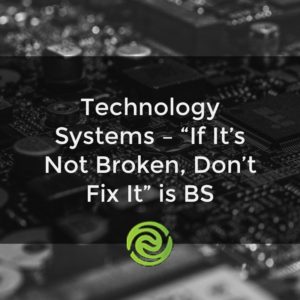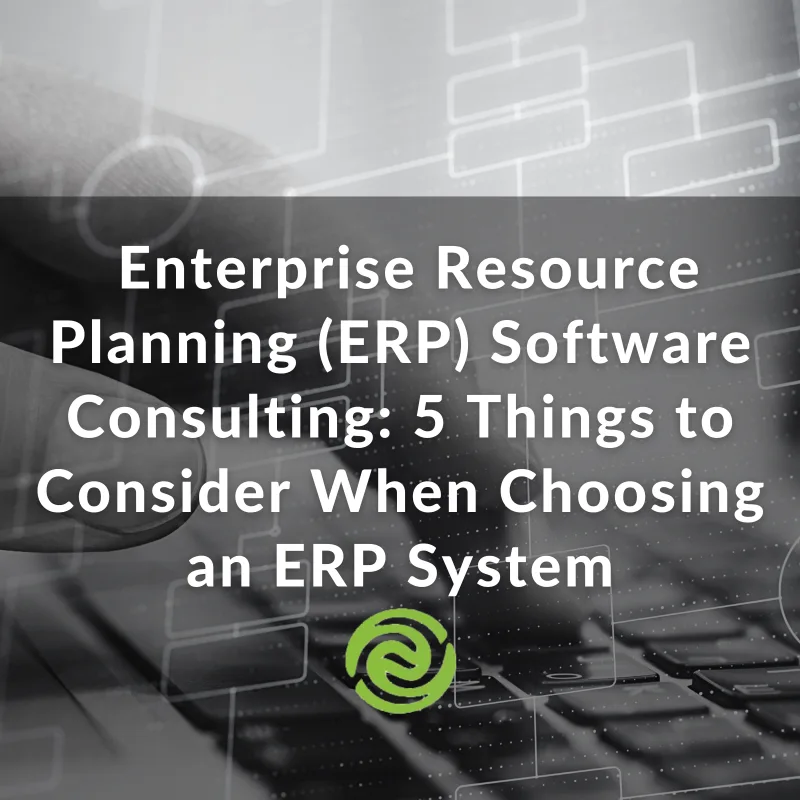A common pain point for many of our prospective clients is the persistent challenge of…
Technology Systems – “If It’s Not Broken, Don’t Fix It” is BS
 The old adage, “if it’s not broken, don’t fix it,” may work fine for some things, but it’s BS when it comes to technology.
The old adage, “if it’s not broken, don’t fix it,” may work fine for some things, but it’s BS when it comes to technology.
The best time to “fix,” or update, clean, and maintain your software systems, cloud infrastructure, servers, and business systems is before they break. Before you get into technical debt so far you can’t afford to get out.
Technical debt is when software, hardware, or code need updates/upgrades to work at full capacity, yet those updates are not implemented. This debt builds up over time and bogs down the processes needed to run your business, which cuts into productivity and detracts from your bottom line.
So, how do you know when to fix your technology if it’s not broken? And how do you know it will improve performance?
Determine if You Need a Tech Fix
If you have an old system that’s still working to get the job done – albeit with a lot of attention – you’re probably aware that you need to change it but the thought of it is just too much to bear. You’re busy, you don’t have time to deal with it. You have no idea what it will cost. It’s overwhelming and frustrating. You’re not sure where to begin or who can help.
First, determine if you need a tech fix. Start by answering the following questions. If you say “yes” to any of them, you’re in the fix-it category. If maintenance is needed, there is help available.
- Is your software or business IT system decades old?
- Do your company computers still have blue or green screens?
- Every time you try to update/upgrade software it takes forever or won’t apply?
- Are you using Google Sheets, Excel, or Microsoft Access as a companywide database/business system?
- Have you been ignoring your IT systems?
- Have you been spending too much time on your IT systems?
Nextgov.com reports that in 2016 private companies spent approximately 70% of their IT budget maintaining legacy systems.
Legacy Systems Impact Bottom Line
If you’re still using a legacy system, like an old Windows platform, or dare I say MS-DOS, these will still power your business processes, but with a negative impact on your bottom line. Unfortunately, you don’t know what you don’t know. How much is this system holding you back? How secure is it? What is it costing in lost productivity and customer success?
Even software systems that are just a few years old can pose risks when it comes to compatibility with newer versions and updates. They may take a long time to update or won’t update at all, which leaves your organization vulnerable to a host of system glitches and hackers – a potentially costly and devastating outcome that’s more likely than most people realize.
Maybe you haven’t thought about your technology in a while because it’s “working just fine.” Guess what? It’s probably not. If it’s been over a year, have your IT person or external software systems partner assess your situation and perform security checks before you get too far into technical debt and lose your competitive edge.
Using Spreadsheets as a Companywide Database?
Microsoft Excel and its newer cousin, Access, are both important business applications – for single-user interfaces. Your financial department probably uses spreadsheets to create financial models, formulas, charts, graphs, etc. Are you also trying to use them for inventory control? Production?
Let’s say you’re using Access as a Customer Relation Management (CRM) tool, which is its purpose … but somehow, it’s progressed to your HR department and/or Production Manager also using it to store and manage data.
Data entry/management with these single-user software systems is manual (costing hours of time) and companywide daily updates are difficult – especially without fear of losing irreplaceable information. Effective cross-communication is nearly impossible, and it can take hours to migrate data, sometimes overnight. Within a year, essential upgrades may not have a migration path to take the next step up, then what? Technical debt.
Technical debt is widespread with software and business systems. When you’re finally forced to update, you’ll be so far behind, the financial and time expenditures will be much greater than necessary. The consequence is a negative impact on profitability.
Even If It’s Not Broken, Update & Upgrade
Even if it’s not broken and seems to be working fine, it is necessary to manage and update your technology on a regular basis – at least once per year. Technology is changing faster than most of us can keep up with and those changes are usually implemented for a reason, to increase efficiency and security.
If your software systems are maintained, when it’s time for an upgrade, the transition to a newer version will be less stressful and costly.
Implementing updates and upgrades or changing to the right software and business systems for your business will surprise you as you discover what you were missing:
- Improved departmental productivity.
- Enhanced sales and customer relations/retention.
- More accurate reporting.
- Company-wide efficiency.
- Better company culture.
- Extra data safety, fewer legal ramifications.
- Reduced maintenance costs.
- New market demands met with ease.
It can feel risky upending the status quo and fear of the unknown is human nature, but you have too much to lose if you do not take upgrading your IT seriously.
Every 5 years a company will spend more money on legacy maintenance, outdated software, and business systems they will never use than it did on the actual software. – CIO
The Bottom Line …
Still feel like, “it’s not broken, I don’t want to mess with it?” Then ask yourself, how many daily person-hours, from executives to production workers, are being spent on working within and managing data in inefficient software, hardware, and business systems? How much is outdated IT chipping away at your bottom line? Depending on the nature of your business, it could be thousands of dollars per hour or per day.
Don’t fall into the technical debt trap! Whether you have an internal IT person/department or not, there is help available to move your company into more cost-effective, efficient systems. Swip Systems is a team of software specialists based in St. Louis, Missouri, who can evaluate your company’s IT and make recommendations for the most immediate fixes – always with your best interests in mind. We love to help and offer no-obligation advice. Contact us today. 877.377.SWIP







